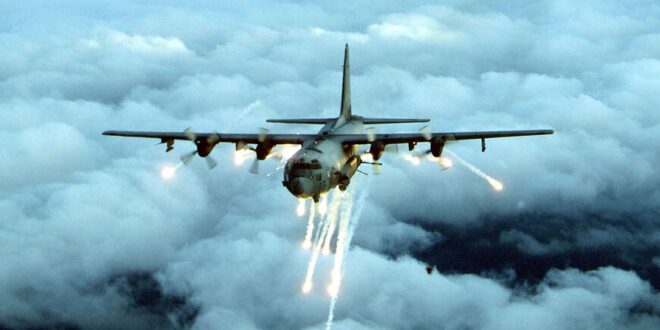US commanders ordered lethal strikes in quick response to a missile attack on the Ain al-Asad air base, in a sign the military is taking matters into its own hands to defend its personnel in Iraq.
The Pentagon said an American AC-130 gunship struck Iran-backed militia vehicles and personnel in western Iraq in retaliation for a ballistic missile attack on the Ain al-Asad air base, which houses US troops.
Iran-backed militia personnel launched at least one “close-range ballistic missile” at the air base west of Baghdad late on Monday, injuring at least eight US personnel and damaging an unoccupied warehouse, defense officials told Al-Monitor.
Pentagon officials billed the AC-130 strikes as defensive action in response to the missile attack, which marked a new escalation as Washington seeks to contain the fallout from Israel’s war in Gaza.
“The self-defense strike resulted in some hostile fatalities,” Pentagon deputy press secretary Sabrina Singh told reporters on Tuesday.
Why it matters: The exchange marked the first time the Pentagon has acknowledged responding with lethal force against Iraqi militia personnel in roughly two years, signaling escalation as Iran-backed groups have continue to threaten US bases in the region over Washington’s support for Israel’s campaign against Palestinian militants in the Gaza Strip.
It also marked the second time US troops in Iraq have been targeted with a ballistic missile in recent years. In January 2020, Iran’s Islamic Revolutionary Guard Corps (IRGC) fired at least 16 ballistic missiles from Iranian territory at Ain al-Asad and another airbase in Iraq’s Kurdistan region in retaliation for the US assassination of then-Quds Force chief Qasem Soleimani in Baghdad.
Monday’s attack seemed to confirm the IRGC has passed short-range ballistic missiles onto the factions it supports in Iraq, though US officials did not specify which militias were behind the attack.
The US military’s swift retaliation suggest a more aggressive posture after three rounds of carefully tailored nighttime airstrikes targeting IRGC-linked facilities in Syria in recent weeks have failed to halt a renewed pattern of militia rocket and drone barrages. Singh on Tuesday suggested however that the US military has carried out additional undeclared responses to the attacks.
Last night’s barrage by the artillery-laden AC-130 barrage came at the direction of US commanders in immediate response to the missile attack, and did not require prior approval by the White House, defense officials said.
The AC-130 was already in the air nearby when the ballistic missile attack was fired, Singh said Tuesday. “They were able to take action because they saw … the movement of these militants as they moved into their vehicles,” she told reporters.
Singh would not specify whether the AC-130 was airborne in response to any perceived threat by US forces or happened to be over the area by chance. “I do not believe it was in a position to prevent [the launch],” she said.
Suspected IRGC-backed militias have launched some 66 rocket and drone barrages targeting US bases in Iraq and Syria over the past several weeks, breaking a nearly year-long lull on Oct. 17 after Hamas accused Israel of being behind a deadly explosion at a hospital in Gaza Strip, a charge the Israeli military has denied.
Militia officials and social media accounts affiliated with the IRGC-backed groups have repeatedly threatened to target US bases in the region in response to Washington’s support for Israel’s war effort in Gaza, which has killed more than 11,000 Palestinians.
The Ain al-Asad base in Iraq has thus far borne the brunt of the attacks, for which Washington has publicly and privately warned it will hold Iran accountable. Earlier this month, a senior US defense officials went so far as to threaten to strike IRGC personnel. “We are not taking anything off the table,” Singh told reporters Tuesday.
At least 62 US personnel have been hurt in the near-daily attacks, with many evaluated for suspected traumatic brain injuries, though military officials say US air defenses have deflected most of the barrages.
New escalation: Monday’s attack on Ain al-Asad involved at least two ballistic missiles, one of which landed in an open field, according to two US defense officials who cited an initial assessment. At least one drone targeted the base in the hours prior to the missile barrage, resulting in no damage or casualties, one of the officials said.
No group has publicly claimed credit for the missile attack.
 Eurasia Press & News
Eurasia Press & News



